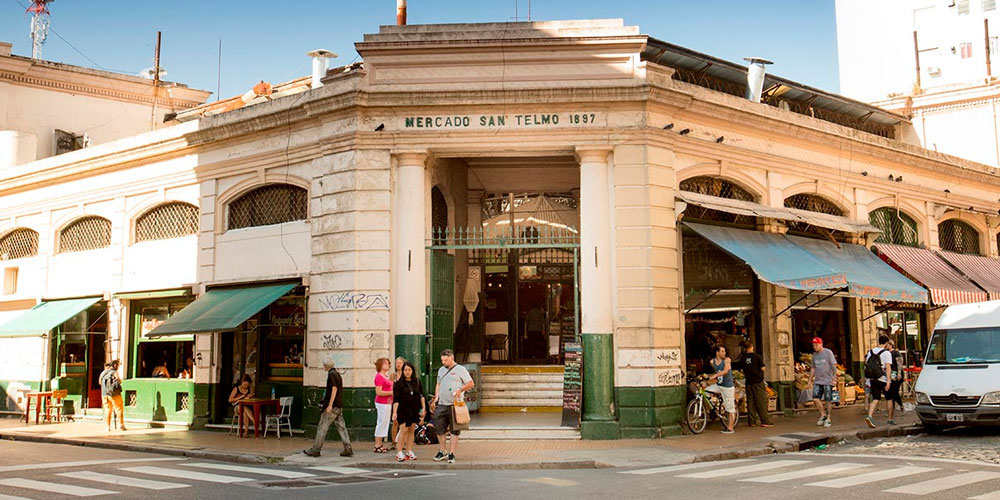What to do in San Telmo, a list with the best options to visit in this beautiful Buenos Aires neighborhood.
The San Telmo neighborhood is the second oldest in the city and despite being the smallest of all, it concentrates much of the spirit of colonial Buenos Aires mixed with a strong culture of diversity, immigration and unique traditions such as its famous Sundays Fair.
The neighborhood can be visited any day during the week is very quiet, with a little more activity closer to the weekend. Without a doubt, the best day to visit it if you want to fully enjoy it is Sunday, when the traditional fair takes place.
A good plan if you are there on Sunday and want to delve deeper into the history of the oldest part of the city, is to join our tour of San Telmo, which begins in the morning in the Jesuit block in Montserrat and enters the heart of San Telmo where you can enjoy its beautiful fair in the afternoon.
Here we are going to tell you everything about what to do in San Telmo:
San Telmo Market
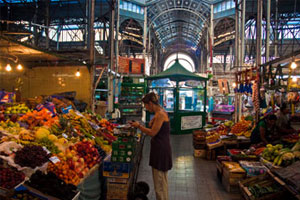 The San Telmo market is one of the few large markets that continue to function of those that existed in all the Buenos Aires neighborhoods at the end of the 19th century. It was built by the architect Buschiazzo in 1897 and served as a large market supplier of fruits, vegetables and food. The building has an iron arched structure that is wonderful. Today the market is a mixture, it still has some stands selling food such as butcher and greengrocers, but some antique dealers have also been established since the neighborhood organized the antiques fair in the 70s and in recent years the market began to evolve into a very rich and varied gastronomic pole with grills, coffees, sandwich shops and all kinds of food on the way and in the bar.
The San Telmo market is one of the few large markets that continue to function of those that existed in all the Buenos Aires neighborhoods at the end of the 19th century. It was built by the architect Buschiazzo in 1897 and served as a large market supplier of fruits, vegetables and food. The building has an iron arched structure that is wonderful. Today the market is a mixture, it still has some stands selling food such as butcher and greengrocers, but some antique dealers have also been established since the neighborhood organized the antiques fair in the 70s and in recent years the market began to evolve into a very rich and varied gastronomic pole with grills, coffees, sandwich shops and all kinds of food on the way and in the bar.
Here we leave you more information!
San Telmo Fair and Dorrego Square
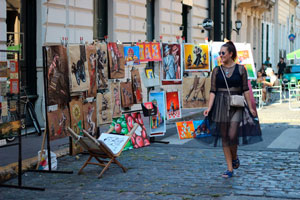 The San Telmo Fair takes place every Sunday and originated around the famous Dorrego Square, the second oldest square in the city after Plaza de Mayo. There, surrounded by picturesque colonial and classic buildings and with the towers of the church of San Telmo in sight, antique dealerships are established that since 1970 have sold artistic objects of all kinds. The fair began as an idea by the architect José María Peña as a way to rescue the neighborhood and its traditions and invite everyone to visit the neighborhood on weekends.
The San Telmo Fair takes place every Sunday and originated around the famous Dorrego Square, the second oldest square in the city after Plaza de Mayo. There, surrounded by picturesque colonial and classic buildings and with the towers of the church of San Telmo in sight, antique dealerships are established that since 1970 have sold artistic objects of all kinds. The fair began as an idea by the architect José María Peña as a way to rescue the neighborhood and its traditions and invite everyone to visit the neighborhood on weekends.
More information about Dorrego Square here!
San Pedro Gonzalez Telmo Church
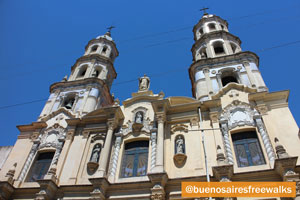 The San Telmo neighborhood takes its name from Saint Pedro Gonzalez Telmo, protector of sailors. The church that takes its name is located a few meters from Plaza Dorrego and is one of the most beautiful in Buenos Aires. It is a colonial church originally built by Jesuits but which was later clad in the 19th and 20th centuries with a Baroque-Iberian facade. Inside there are several paintings of saints in the Buenos Aires filleting style. Next to the church is the colonial cloister that today is the prison museum.
The San Telmo neighborhood takes its name from Saint Pedro Gonzalez Telmo, protector of sailors. The church that takes its name is located a few meters from Plaza Dorrego and is one of the most beautiful in Buenos Aires. It is a colonial church originally built by Jesuits but which was later clad in the 19th and 20th centuries with a Baroque-Iberian facade. Inside there are several paintings of saints in the Buenos Aires filleting style. Next to the church is the colonial cloister that today is the prison museum.
Ezeiza Family House | The Defense Passage
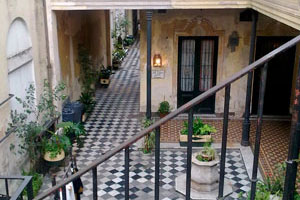 On Defense Street, reaching Avenida Independencia, there is an old house built in 1876 for the Ezeiza Family. The house is one of the last aristocratic residences built in the neighborhood during the great move of wealthy families to Recoleta. It is an Italian-style residence with lined courtyards, iron columns and even the old cistern that has been maintained, creating an atmosphere of old Buenos Aires before the great development of French academicism towards the north of the city. Undoubtedly one of the most picturesque places in San Telmo. Today the house is a commercial gallery called The Defense Passage (Pasaje la Defensa) with clothing, handicraft and antique shops.
On Defense Street, reaching Avenida Independencia, there is an old house built in 1876 for the Ezeiza Family. The house is one of the last aristocratic residences built in the neighborhood during the great move of wealthy families to Recoleta. It is an Italian-style residence with lined courtyards, iron columns and even the old cistern that has been maintained, creating an atmosphere of old Buenos Aires before the great development of French academicism towards the north of the city. Undoubtedly one of the most picturesque places in San Telmo. Today the house is a commercial gallery called The Defense Passage (Pasaje la Defensa) with clothing, handicraft and antique shops.
French Solar Gallery (Galería Solar de French)
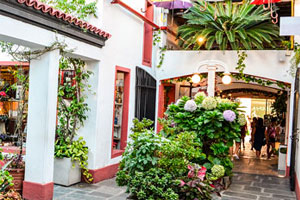 This gallery is the most “intagram friendly” place in San Telmo. It is a commercial promenade located on the site where the patriot Domingo French lived. The house has kept its old layout of consecutive courtyards with beautiful plants and flowers and covered in colorful umbrellas, a fashion started in Portugal and spread throughout the world, to give a magical touch to the environment.
This gallery is the most “intagram friendly” place in San Telmo. It is a commercial promenade located on the site where the patriot Domingo French lived. The house has kept its old layout of consecutive courtyards with beautiful plants and flowers and covered in colorful umbrellas, a fashion started in Portugal and spread throughout the world, to give a magical touch to the environment.
So, if you don’t know what else to do in San Telmo, a good option is to enter this beautiful house and take lots of photos!
Minimum House (Casa Mínima)
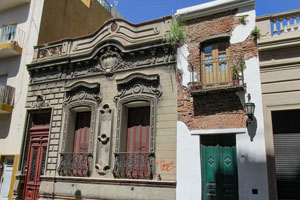 In San Telmo is the narrowest house in Buenos Aires. It is a facade of only 2.5 meters located in the picturesque San Lorenzo Passage and which is popularly known as “the minimal house”. The legend says that a freed slave lived there and the house would be a connection with that old Buenos Aires past where the Afro-descendant population was still a large part of the population of colonial Buenos Aires. The reality is a bit more disappointing: architect José María Peña, who founded the San Telmo fair and was an expert on heritage, concluded that the minimal house is a subdivision into parcels of a larger old property. Likewise, the minimal house continues to enchant all visitors to San Telmo for its curious appearance and the legends that surround it.
In San Telmo is the narrowest house in Buenos Aires. It is a facade of only 2.5 meters located in the picturesque San Lorenzo Passage and which is popularly known as “the minimal house”. The legend says that a freed slave lived there and the house would be a connection with that old Buenos Aires past where the Afro-descendant population was still a large part of the population of colonial Buenos Aires. The reality is a bit more disappointing: architect José María Peña, who founded the San Telmo fair and was an expert on heritage, concluded that the minimal house is a subdivision into parcels of a larger old property. Likewise, the minimal house continues to enchant all visitors to San Telmo for its curious appearance and the legends that surround it.
Zanjón de Granados
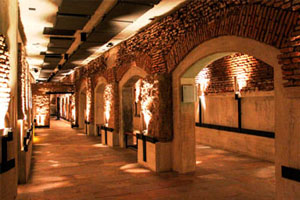 In 1985, by accident, a businessman who had invested buying an old house from 1830 for a gastronomic project found archaeological remains of the tubing of the old Tercero del Sur, a stream that crossed San Telmo and emptied into the Río de la Plata. This businessman then decided to change his plans and dedicate himself completely to the archaeological rescue of the ancient tunnels that can be visited today. It is undoubtedly the best archaeological site in Buenos Aires and the only place where tunnels under the city can be seen in a clear and accessible way. The visit is paid and with a guide, so we recommend scheduling it or leaving it for a second visit to the neighborhood or if you live in Buenos Aires. Although it is interesting, for international or foreign tourists who will only spend a day in the neighborhood, it can be ignored.
In 1985, by accident, a businessman who had invested buying an old house from 1830 for a gastronomic project found archaeological remains of the tubing of the old Tercero del Sur, a stream that crossed San Telmo and emptied into the Río de la Plata. This businessman then decided to change his plans and dedicate himself completely to the archaeological rescue of the ancient tunnels that can be visited today. It is undoubtedly the best archaeological site in Buenos Aires and the only place where tunnels under the city can be seen in a clear and accessible way. The visit is paid and with a guide, so we recommend scheduling it or leaving it for a second visit to the neighborhood or if you live in Buenos Aires. Although it is interesting, for international or foreign tourists who will only spend a day in the neighborhood, it can be ignored.
Mafalda
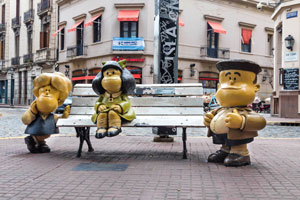 In San Telmo there is part of the “Paseo de la Historia” (Comic Tour), a series of nice statues that remind us of great people from Argentine comic strips and comics from the 60s and 70s mostly. At the corner of Defensa and Chile is the most famous and beloved character of all: Mafalda, who according to its author Quino lives in the San Telmo Neighborhood. It is common to see tourists from all over the world lining up to get their precious photo with this girl who touches the hearts of all Argentines.
In San Telmo there is part of the “Paseo de la Historia” (Comic Tour), a series of nice statues that remind us of great people from Argentine comic strips and comics from the 60s and 70s mostly. At the corner of Defensa and Chile is the most famous and beloved character of all: Mafalda, who according to its author Quino lives in the San Telmo Neighborhood. It is common to see tourists from all over the world lining up to get their precious photo with this girl who touches the hearts of all Argentines.
Lezama Park and National Historical Museum
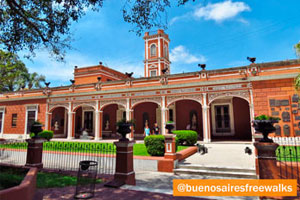 Lezama Park is a traditional park, it was originally the Garden of the House of José Gregorio Lezama and later donated by his widow to the city of Buenos Aires. The park is characterized by its romantic design of winding paths, gazebos, statues, vessels, and an old amphitheater. Also there is the monument to Pedro de Mendoza and on Calle Brasil street the Russian Orthodox church that dazzles with its Moscow style. On Defense Street, the old Lezama mansion in a picturesque Italian style remains, which today is the National Historical Museum, a must for those interested in Argentine history.
Lezama Park is a traditional park, it was originally the Garden of the House of José Gregorio Lezama and later donated by his widow to the city of Buenos Aires. The park is characterized by its romantic design of winding paths, gazebos, statues, vessels, and an old amphitheater. Also there is the monument to Pedro de Mendoza and on Calle Brasil street the Russian Orthodox church that dazzles with its Moscow style. On Defense Street, the old Lezama mansion in a picturesque Italian style remains, which today is the National Historical Museum, a must for those interested in Argentine history.
Caseros Avenue
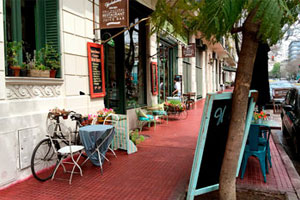 Caseros Avenue separates the San Telmo neighborhood from Barracas and is where some of the most beautiful buildings in the area were built. There the houses were built for the British workers of the Southern Railway called “tenement of the English” in a beautiful building that transports us to a classic European boulevard. Continuing uphill we also find several very beautiful buildings. Today the avenue has become a gastronomic pole with an interesting offer of bars and restaurants.
Caseros Avenue separates the San Telmo neighborhood from Barracas and is where some of the most beautiful buildings in the area were built. There the houses were built for the British workers of the Southern Railway called “tenement of the English” in a beautiful building that transports us to a classic European boulevard. Continuing uphill we also find several very beautiful buildings. Today the avenue has become a gastronomic pole with an interesting offer of bars and restaurants.
We invite you to join our San Telmo Tour here!
